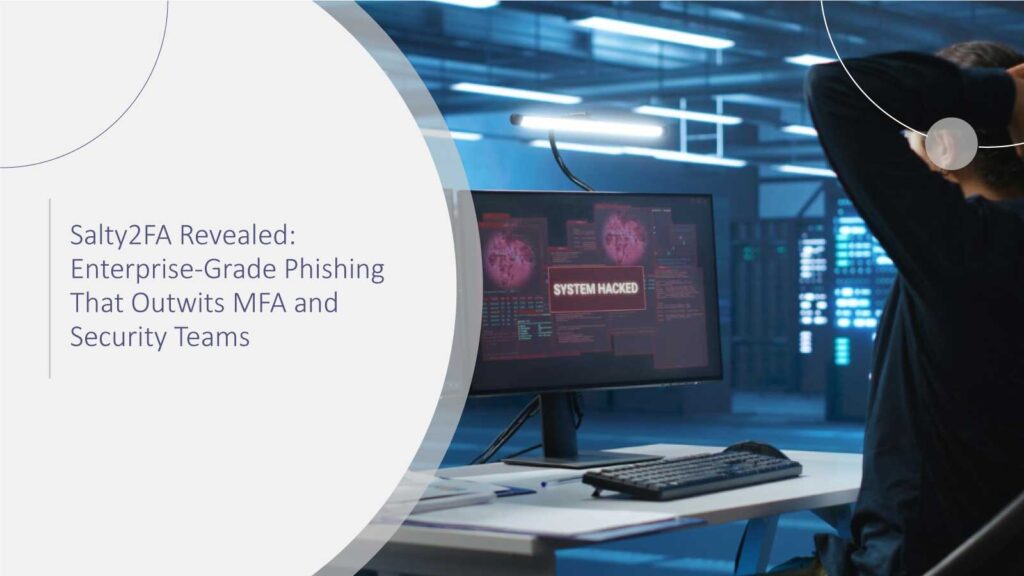Shallow phishing has always been the simplest target of cybercrime – just the usual typos-riddled emails, suspicious links, and crude imitations. But the scenario of phishing has changed. A new phishing framework called Salty2FA-fraudsters has been reenergized with the precision and discipline of software developers used in the management of enterprise applications, and traditional detection tools are struggling. According to Gartner, 82% of breaches involve phishing as a primary attack vector.
In this piece, we examine the progression of phishing, take apart the framework of Salty2FA, and investigate measures against these versatile attackers that may be implemented in one’s organization.
What is Salty2FA? A demonstration of the new era of Phishing
Salty2FA is not your typical phishing toolkit. This framework is constructed with the same level of sophistication as a large-scale enterprise that employs numerous evasion tactics and adaptive infrastructure. McKinsey reports that modern cybercriminals are adopting software-engineering practices similar to enterprise development.
These aspects characterize Salty2FA:
- A/Veil of Genuine Platforms: The malefactors make use of rigorously spotless applications like Aha.IO to put up Phishing lures. What they do is allow user trust in generally recognized services and then coax them to engage and compromise credentials.
- Phased Method of Operation: The attack chain incorporates Cloudflare Turnstile security, session-based rotating subdomains, and credential-harvesting pages. Such a multistorey design lets most conventional automated defenses slip by, and thus, the attack moves on without being detected.
- YouTube-like Branding: Salty2FA modifies fake logins to closely resemble the victim’s company portals. Logos, colors, and other style elements are not unique to technology but are the victim’s domain, thus affecting healthcare, finance, tech, energy, and automotive sectors.
- Stealthy Attack Techniques: The utilization of anti-geoblocking technology, ASN/IP filtering, and JavaScript-based anti-debug practices completely prevents security researchers and SOC teams from gaining easy access to the campaign for analysis purposes.
- Phantom Multi-Factor Authentication: The framework adeptly imitates six different 2FA methods, thus fooling even organizations that have implemented MFA into thinking that it is safe.
Detecting and Defending Against Enterprise-Grade Phishing
Given the intricacy of Salty2FA, a multi-layered approach is required to defend against it:
Behavioral Monitoring
Phishing detection through signature identification should be only a minor part. Monitoring unusual login activities, access requests from locations not known, and interactions with a fake MFA prompt could be considered. Menlo Security observed a 140% increase in browser-based phishing attacks in 2025 compared to 2023, with a 130% rise in zero-hour attacks. Gartner advises that AI-driven behavioral analysis reduces phishing-induced credential compromise by up to 60%.
Dynamic Inspection
The process of runtime analysis on scripts and pages can help discover different stages of the attack, which are hidden from static scanning. Imagine this process as if the attacker were allowed to perform all the steps of his plan, but you were there observing and analyzing.
Phishing-Resistant Authentication
Hardware-based authentication like FIDO2, WebAuthn, or U2F tokens is the only way; even if your credentials are stolen, they won’t be able to use them again.
Continuous Education and Simulation
The training of the users can be done through realistic simulations, which can be around subtle hints like domain anomalies or unexpected MFA prompts. An educated user is a very important part of the security system.
Cross-Platform Protection
Provision of endpoint, mobile, and app security solutions that seamlessly integrate with your email and network defense systems to identify threats at multiple stages is highly recommended.
Expert Insights: Navigating the New Phishing Landscape
Industry leaders put forward the main point of these campaigns: sophistication.
According to the explanation of Shane Barney, CISO at Keeper Security:
“Salty2FA represents the coming of phishing 2.0. MFA is no longer a guarantee of safety when the adversaries can simply co-opt the verification methods. Static indicators are doomed to fail; behavior must become the signal.”
He is looking for a suspicious domain that is far from the usual, an unusual Cloudflare Turnstile response, and a dynamic JavaScript execution that can verify the run-time very well, if it is simulating the user interaction,s it can find the execution chain that cannot be seen with the static analysis method. Platforms that rely on hardware for authentication, like FIDO2, WebAuthn, or a U2F token, can totally stop this type of attack by making it impossible to use the intercepted codes.
Brian Thornton, Zimperium, Senior Sales Engineer, further remarks:
“Salty2FA mixes up with legitimate and malicious traffic, so that’s hard to distinguish between them. The defenders are required to take on the advanced layer that covers endpoints, mobiles, and apps with not only email and network, but also security.”
Trey Ford, Chief Strategy and Trust Officer at Bugcrowd, describes the attackers as very professional:
“These are the people who select sophisticated targets for their attacks. They manage to easily get past the security of layered evasion, dynamic branding, and advanced deployment practices, even the toughest ones.”
Nicole Carignan, SVP of Security & AI Strategy at Darktrace, outlines the role of learning by machine:
“A company definitely needs a human staff, but cannot rely on them solely as the last defense. AI-driven tools that comprehend the usual user behavior must be readily available to spot fresh or unrevealed threats.”
Humanizing the Threat: Why We Should Care
What if this phishing scenario were a login page identical to your corporate portal, with even the colors, fonts, and logos? You enter your login information and finish the 2FA prompt, and then realize the system you were using was just a mimic. It is unsettling, isn’t it?
Salty2FA is designed to take advantage of trust, and it does so at a level that has never been seen before. For IT leaders, security teams, and tech enthusiasts, the message is obvious: phishing acts differently now, but we still have the same game.
To be honest, if phishing campaigns were like video games, then Salty2FA would be that boss level where the enemies you have to fight become more at times unpredictable, the little helpers work together, and the traps pop up suddenly. Not paying attention to this change is similar to going to a laser tag game with a water gunit’s going to get hurt badly.
Conclusion
Salty2FA is the kind of future multi-phishing that entertains characteristics like enterprise-level, multi-stage, and bypassing even that which is termed as absolute safety, like MFA and traditional defenses. In order to be resistant, organizations have to adopt advanced behavioral detection, in-depth run-time inspection, hardware-based authentication, and regular user education. Gartner predicts that by 2026, organizations that combine AI-driven monitoring with layered defenses will reduce phishing breaches by 70%.
Phishing has developed to the extent that it is beyond the sphere of emails only. It is a smart software operation conducted by highly skilled opponents. Organizations can stay ahead of the attackers if they accept the transformation, implement layered defenses, and use the AI-powered monitoring tool.
FAQs
1. What is Salty2FA?
Salty2FA is a multiple complex task of social engineering (phishing) which pretends to be an enterprise system and overcomes the traditional security systems, including multi-factor authentication, without notifying the victim.
2. How does Salty2FA evade detection?
By multi-stage infrastructure, ephemeral subdomains, Cloudflare Turnstile protection, JavaScript anti-debugging, and geo-blocking, it avoids detection with both bots and humans.
3. Can MFA protect against Salty2FA?
While MFA is a layer of security, there is a possibility that Salty2FA can simulate six different MFA methods with great accuracy. Hardware-based tokens like the FIDO2 or WebAuthn token provide the best security.
4. Which industries are targeted?
Salty2FA targets various industries such as healthcare, finance, technology, energy, and automotive. It achieves that by dynamically branding phishing pages to look like corporate portals.
5. How can organizations defend against Salty2FA?
Organizations should not rely on just one security measure, and that is why they must use behavioral detection, run-time inspection, phishing-resistant authentication, AI-powered monitoring, and continuous employee training for their layered defense strategy.
For deeper insights on agentic AI governance, identity controls, and real‑world breach data, visit Cyber Tech Insights.
To participate in upcoming interviews, please reach out to our CyberTech Media Room at sudipto@intentamplify.com.







